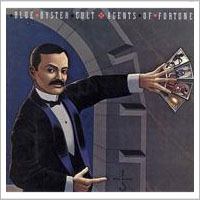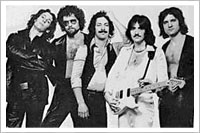By Steve Rhodes
“(Don’t Fear) the Reaper” will live on in some minds as the greatest cowbell song ever (lovingly) parodied on Saturday Night Live, but the album from which that timeless classic sprang is as surprising and mysterious a recording as the band that made it.
 Despite the umlaut, Blue Öyster Cult was hardly an ordinary heavy metal band in 1976, when “Reaper” was released as a single off Agents of Fortune. While the album’s cool-ass cover art suggested polished Zeppelin psychedelia, Agents of Fortune was far more an amalgam of ’50s pop and ’70s New Wave. Though “Reaper” lives on in classic rock radio infamy, Agents also featured the vocals and two poems put to music of New Wave pioneer Patti Smith (she opens “The Ballad of Vera Gemini” intoning “You’re boned like a saint/With the consciousness of a snake”). Two other songs were written to the lyrics of H. Robbins – also known to New York New Wavers as Helen Wheels. (Smith’s guitarist and collaborator Lenny Kaye wrote the liner notes to the remastered 25th anniversary edition of Agents, released in 2001 and including the original demo of “Reaper.”)
Despite the umlaut, Blue Öyster Cult was hardly an ordinary heavy metal band in 1976, when “Reaper” was released as a single off Agents of Fortune. While the album’s cool-ass cover art suggested polished Zeppelin psychedelia, Agents of Fortune was far more an amalgam of ’50s pop and ’70s New Wave. Though “Reaper” lives on in classic rock radio infamy, Agents also featured the vocals and two poems put to music of New Wave pioneer Patti Smith (she opens “The Ballad of Vera Gemini” intoning “You’re boned like a saint/With the consciousness of a snake”). Two other songs were written to the lyrics of H. Robbins – also known to New York New Wavers as Helen Wheels. (Smith’s guitarist and collaborator Lenny Kaye wrote the liner notes to the remastered 25th anniversary edition of Agents, released in 2001 and including the original demo of “Reaper.”)
The record opens with “This Ain’t the Summer of Love,” a declaration that amply demonstrates a band in the crevice between ’60s rock, Zeppelin affectations and the infiltration of the CBGBs crowd – with a bit of metal pop bravado.
Feeling so easy on the outside
But not so funny on the inside
Feel the sound and pray for rain
Cause this is the night we ride
Track two is “True Confessions” – Fats Domino meets FM radio with a dash of lyrical prowess.
Stand in the doorway in a jealous rage
Drag myself ‘cross her wild terrain
“True Confessions” declares the singer and his antagonist “modern lovers” and recalls the fun they had, perhaps at an emotional price not worth admitting, but “naked, exposed like fine rock and roll.”
And that’s the windup to the record’s big hit slot – but what comes next doesn’t sound like anything that came before, or even much like what follows. That familiar guitar figure that opens up “Reaper” is a revelation, even as the song is shrouded in ambiguity. You’re never quite sure what it’s all about, but between the haunting vocal and lyric, you’re pretty sure death, evil, and rock ‘n’ roll are involved, and that’s kind of the metal trifecta, isn’t it?
(In the re-release liner notes, Donald “Buck Dharma” Roeser says that the song is not, as rumored, a suicide apologia, but a suggestion that a romance could “endure beyond the death of lovers, on the other side of the veil.” Silly Buck.)
It’s a weird song to have had such a long, popular life. The call-and-response-ish vocals are more present than telltale metal characteristics as power chords. Oddly, it’s dangerously close to being BOC’s pussy song (Think “Beth”), despite the menacing, screeching little guitar jag at the break. (Lanie, in The Stöned Age, declares Agents of Fortune “a total fuck album.”) And yet, something urgent and dangerous is unfolding here. “Love of two is one/Here but now they’re gone.”
The rest of the record isn’t as elusive, but nearly as enjoyable. BOC was way ahead of the curve on the sci-fi front, what with “the awful truth,” “the saucer news,” “fairy rings and tower beds,” and the lyric “I hear the music daylight disc/Three men in black said, ‘Don’t report this . . . ” on “E.T.I (Extra Terrestrial Intelligence).”
“Sinful Love” is the dark side of “True Confessions,” using a similar piano rhythm with a dark guitar line and a hell of an opening lyric.
You’re over my shoulder, I think I’m possessed
Your constant undertone is making me toothless
Time’s come to trim you, gonna get out my knife
Gonna cut you out baby, out of my life
Then the background vocals come in wailing “Daredevil, She-devil, Printer’s Devil, Evil!” followed by our bitter, escaping lover declaring “I love you like sin, but I won’t be your pigeon.”
I mean, c’mon!
The other Patti Smith song, “Debbie Denise,” winds up the record with the kind of majestic segments that I could swear I’ve heard as Olympic broadcasts go to commercial.
But revisiting this album now is best done through the 25th anniversary remastered re-release of 2001 (produced for re-issue by Bruce Dickinson – who did not produce the original, much less ask for more cowbell – though another producer did). There you’ll find, in Kaye’s liner notes, Roeser musing about the popular appeal of “Reaper,” which hit No. 12 on the American charts in October ’76, after 20 weeks on the Hot 100. “We didn’t think of ourselves as a pop band at all,” Roeser says.
 Indeed, up until then, as Kaye’s liner notes describe, BOC, with three studio albums and one live effort under its belt, was known as “the thinking man’s metal band.” (The BOC catalog, after all, includes albums such as Tyranny and Mutation; Cultosaurus Erectus; and Career of Evil.)
Indeed, up until then, as Kaye’s liner notes describe, BOC, with three studio albums and one live effort under its belt, was known as “the thinking man’s metal band.” (The BOC catalog, after all, includes albums such as Tyranny and Mutation; Cultosaurus Erectus; and Career of Evil.)
Still, the record was made at the Record Plant in New York City with Aerosmith and Kiss also in the building. FM rock radio was ascendant – even as a new wave was coming. While Aerosmith and Kiss stuck to their tried-and-true – and eventually went downhill softening up their sound, even if it helped sell records), BOC unexpectedly reflected a moment in time.
This is further demonstrated by the newly released material on the anniversary edition. “Fire of Unknown Origin,” left off Agents but reworked and recorded later, is most musically companionable to “Reaper.” The demo of “Sally,” which was left off the record, has vocals that are a dead-ringer for Elvis Costello. And “Dance the Night Away” (not the Van Halen song), was never recorded for real by the band but later released by co-writer Jim Carroll, of Basketball Diaries fame.
But, as Kaye writes, “all paled before the scythe that is The Reaper . . . The track is all unwind, each symphonic section inevitable.”
Given the familiarity we have with the song, Roeser’s 6-minute, 20-second four-track home demo (sans cowbell) is amazing.
The guts of the song are the same, but the raw version is more compelling in many ways than what ended up on the record – and on the radio. The demo opens with a squealing fuzzed-up guitar, which snakes through the entire song, and the drum part is thumped out on pads (or books) with busy fills. It’s not as clean for better and worse. The arrangement and melody is already worked out, though some lyrical spots are still la-la-las – though Romeo and Juliet are already together in eternity. The pacing is more languid, eerie, and alienated.
Kaye describes the final version thusly: “The vocal dialogue is like a devil whispering in one ear, an angel in the other, cajoling and beckoning. There is the assumption that love will still have a value in the hereafter, comforting us in this life. An instrumental breakdown slices out of nowhere, spinning the modal rhymes of raga-rock. You can hear the drone arc out of the mid-break, on endless delay, a pure ray of note that starts in the inaudible and just keeps ringing, like the ringing in your ears after a loud concert. The cymbals crash in time; Reaper fades. They got lasers next.”
Yes. They were influenced by New Wave, but not castrated by it. That was the beauty of BOC.
Scour our bins – from Sonny and Cher to Def Leppard, Labelle to the Clash.
Posted on March 11, 2007


